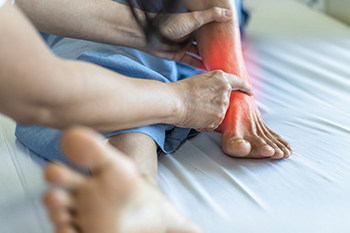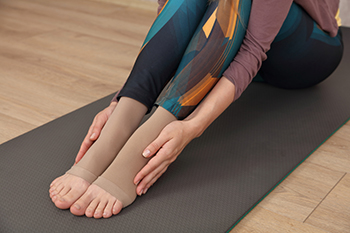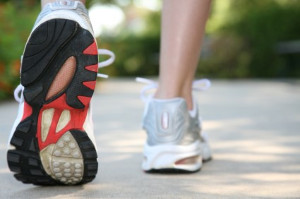

Tarsal tunnel syndrome is a painful condition caused by compression of the tibial nerve as it passes through the tarsal tunnel, a narrow passageway on the inner side of the ankle. This compression leads to symptoms such as numbness, tingling, burning sensations, and sharp pain along the inner ankle and the sole of the foot. The exact cause of tarsal tunnel syndrome can vary, but often includes factors such as injury, trauma, overuse, flat feet, swelling, or the presence of benign growths within the tunnel. Additionally, conditions like arthritis, diabetes, or nerve-related disorders can increase the risk of developing this syndrome. In severe cases, corticosteroid injections or surgical intervention to release the tibial nerve may be necessary to relieve pressure and restore normal nerve function. If you are experiencing ankle pain, it is suggested that you visit a podiatrist who can accurately diagnose tarsal tunnel syndrome, and guide you toward effective treatment methods.
Tarsal tunnel syndrome can be very uncomfortable to live with. If you are experiencing tarsal tunnel syndrome, contact the podiatrists of The Foot & Ankle Center of New Jersey. Our doctors can provide the care you need to keep you pain-free and on your feet.
Tarsal Tunnel Syndrome
Tarsal tunnel syndrome, which can also be called tibial nerve dysfunction, is an uncommon condition of misfiring peripheral nerves in the foot. The tibial nerve is the peripheral nerve in the leg responsible for sensation and movement of the foot and calf muscles. In tarsal tunnel syndrome, the tibial nerve is damaged, causing problems with movement and feeling in the foot of the affected leg.
Common Cause of Tarsal Tunnel Syndrome
The Effects of Tarsal Tunnel Syndrome
A physical exam of the leg can help identify the presence of tarsal tunnel syndrome. Medical tests, such as a nerve biopsy, are also used to diagnose the condition. Patients may receive physical therapy and prescriptive medication. In extreme cases, some may require surgery.
If you have any questions please feel free to contact our office located in Paramus, NJ . We offer the newest diagnostic and treatment technologies for all your foot and ankle needs.

To manage poor circulation in the feet, various approaches can be considered. Symptoms may include numbness, tingling, or coldness in the feet. Underlying causes can range from peripheral artery disease to diabetes. Risk factors can include smoking, high blood pressure, and elevated cholesterol levels. Diagnosis often involves undergoing physical exams and ankle-brachial index tests. Improving circulation involves lifestyle changes, such as quitting smoking, regular exercise, and maintaining a healthy weight. Additionally, elevating the feet, wearing compression socks, and managing underlying conditions can help. If symptoms persist or worsen, it is suggested that you schedule an appointment with a podiatrist for further evaluation and treatment.
While poor circulation itself isn’t a condition; it is a symptom of another underlying health condition you may have. If you have any concerns with poor circulation in your feet contact the podiatrists of The Foot & Ankle Center of New Jersey. Our doctors will treat your foot and ankle needs.
Poor Circulation in the Feet
Peripheral artery disease (PAD) can potentially lead to poor circulation in the lower extremities. PAD is a condition that causes the blood vessels and arteries to narrow. In a linked condition called atherosclerosis, the arteries stiffen up due to a buildup of plaque in the arteries and blood vessels. These two conditions can cause a decrease in the amount of blood that flows to your extremities, therefore resulting in pain.
Symptoms
Some of the most common symptoms of poor circulation are:
Treatment for poor circulation often depends on the underlying condition that causes it. Methods for treatment may include insulin for diabetes, special exercise programs, surgery for varicose veins, or compression socks for swollen legs.
As always, see a podiatrist as he or she will assist in finding a regimen that suits you. A podiatrist can also prescribe you any needed medication.
If you have any questions, please feel free to contact our office located in Paramus, NJ . We offer the newest diagnostic and treatment technologies for all your foot care needs.

Selecting the right pair of running shoes is vital for both comfort and performance. Start by understanding your foot type and running gait, as this will influence the type of shoe you need. Consider factors such as arch height, pronation, and foot width to determine the appropriate level of support and cushioning. Next, prioritize fit, and your running shoes should feel snug but not constrictive, with ample room in the toe box to prevent discomfort and injuries such as black toenails or blisters. Look for shoes with breathable materials to promote airflow and prevent moisture buildup, reducing the risk of fungal infections. Additionally, consider the terrain and distance you'll be running, as different shoes are designed for various surfaces and distances. Finally, it is beneficial to include durability and quality in your shoe choice. This can consist of investing in well-constructed shoes from reputable brands to ensure longevity and support for your running endeavors. By carefully considering these factors, you can find the perfect pair of running shoes to support your fitness journey and enhance your running experience. If you are seeking additional knowledge about what to look for in running shoes, it is suggested that you consult a podiatrist who can provide you with pertinent information.
If you are a runner, wearing the right running shoe is essential. For more information, contact the podiatrists from The Foot & Ankle Center of New Jersey. Our doctors can provide the care you need to keep you pain-free and on your feet.
Choosing the Right Running Shoe for Your Foot Type
To increase performance and avoid the risk of injury, it is important to choose the right running shoe based on your foot type. The general design of running shoes revolves around pronation, which is how the ankle rolls from outside to inside when the foot strikes the ground.
If you have any questions please feel free to contact our office located in Paramus, NJ . We offer the newest diagnostic and treatment technologies for all your foot and ankle needs.

Ankle sprains come in various forms, each accompanied by distinct symptoms that highlight the complexity of this injury. The lateral ankle sprain is the most common, occurring when the foot turns inward,which stretches or tears the ligaments on the outer side of the ankle. Individuals experiencing a lateral sprain may encounter pain, swelling, and difficulty bearing weight on the affected foot. Medial ankle sprains, less frequent but equally impactful, involve damage to the ligaments on the inner side of the ankle, often leading to tenderness and swelling. High ankle sprains affect the ligaments that connect the tibia and fibula, causing pain above the ankle and potentially affecting stability. Regardless of the type of sprain, common symptoms include bruising, limited range of motion, and a feeling of instability. If you have endured an ankle sprain, it is suggested that you visit a podiatrist who can determine which type it is and offer appropriate treatment solutions.
Although ankle sprains are common, they aren’t always minor injuries. If you need your ankle injury looked at, contact the podiatrists from The Foot & Ankle Center of New Jersey. Our doctors can provide the care you need to keep you pain-free and on your feet.
How Does an Ankle Sprain Occur?
Ankle sprains are the result of a tear in the ligaments within the ankle. These injuries may happen when you make a rapid shifting movement while your foot is planted. A less common way to sprain your ankle is when your ankle rolls inward while your foot turns outward.
What Are the Symptoms?
Preventing a Sprain
Treatment of a Sprain
In many cases, the RICE method (Rest, Ice, Compression, and Elevate) is used to treat ankle sprains. However, you should see a podiatrist to see which treatment option would work best with your injury. In severe cases, surgery may be required.
It is important to ask your doctor about rehab options after you receive treatment for your injury. Stretching, strength training, and balance exercises may help the ankle heal while also preventing further injury.
If you have any questions, please feel free to contact our office located in Paramus, NJ . We offer the newest diagnostic and treatment technologies for all your foot care needs.